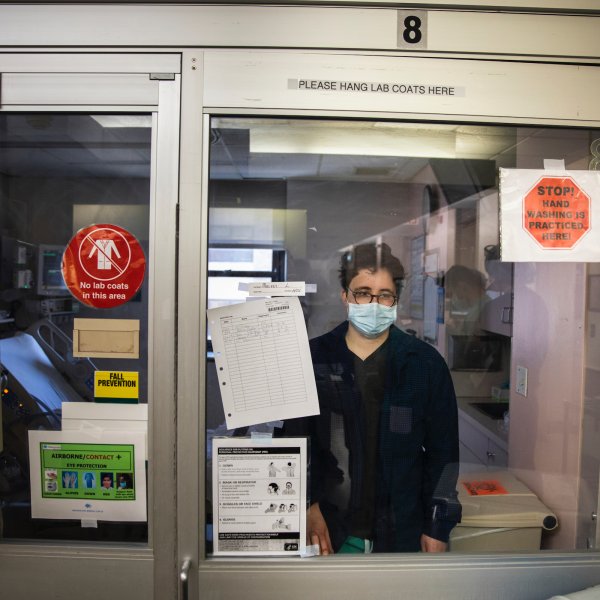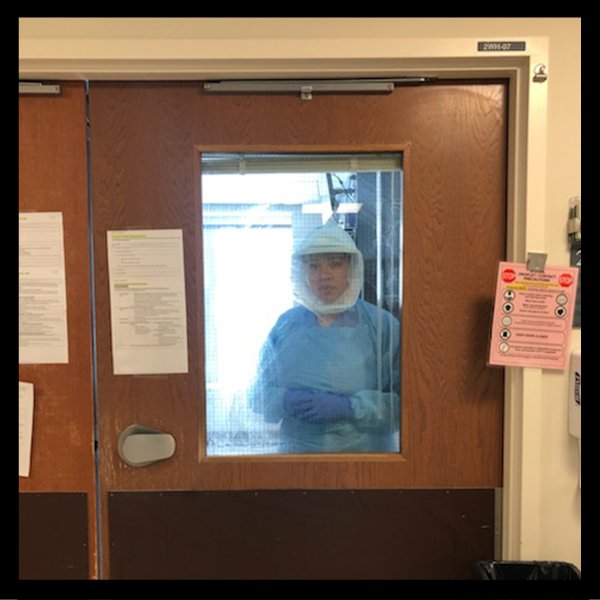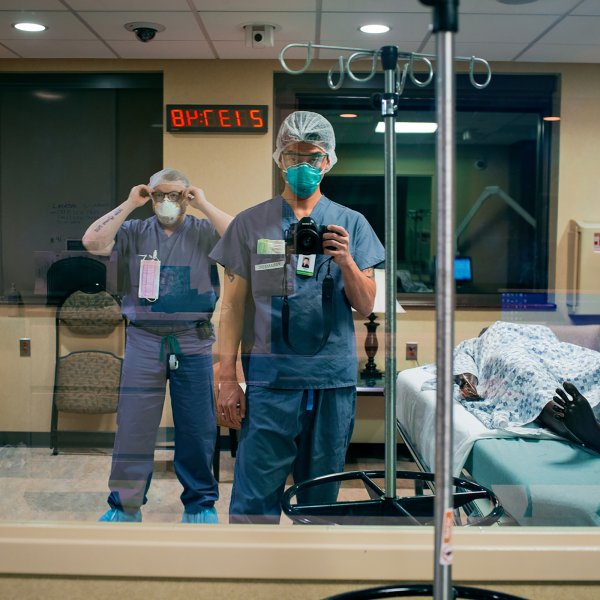The Director of Ohio’s Department of Health, Dr. Amy Acton, is no stranger to adversity. She was once abused by one of her mother’s partners, she bounced around to about 18 different living arrangements in her youth and she even spent one winter living in a tent. But she says her familiarity with disarray positioned her to be ready for a different catastrophe: the gravest pandemic the United States has seen in over 100 years.
“I think because of the childhood I had,” she tells TIME via video chat from the Ohio Statehouse, “that I’m at my best during a crisis.”
Her collective calm amid calamity has played out in front of the Buckeye State and the nation. Before the CDC began issuing nationwide and universal social distancing guidelines, the state health official was working with her Columbus city counterparts to limit the potential for the spread of disease at an annual fitness festival that was expected to draw a couple hundred thousand visitors and at least 22,000 athletes from 80 different countries. With Republican Gov. Mike DeWine and Acton at the helm, Ohio became the first state to shut down all public schools for an extended period of time on March 12. And just five days later, Acton issued a decree cancelling “non-essential or elective surgeries and procedures” that require personal protective equipment—even before New York, America’s epicenter of the virus, announced it was pausing elective procedures.
While President Donald Trump claimed the virus “is going away” on April 3 and tweeted that we were approaching a “LIGHT AT THE END OF THE TUNNEL!” (emphasis his) on April 6, Acton has been using her daily press briefing to treat the rising COVID-19 death tolls and lack of testing resources like the virulent crisis that it is. “Today is the day we have to batten down those hatches,” she somberly urged at her March 22 press conference. “There is no time left. Listen to what Italy is telling us.” On April 7, she doubled down: “You’re winning the war to protect our scarce resources and keeping our hospitals being able to deal with this. The second we let our foot off the gas, the second we are no longer that category 3 hurricane, it can pick up wind again and we can be a category 5.”
Though the warning bells have gotten louder over time, Acton says they first entered her radar in early January. She was on a frightening phone call with the Centers for Disease and Control where a global epidemiologist was talking about an erratic illness that was spreading across China’s Wuhan region. “Something about her voice and what she was saying made me think this is zoonotic,” which means transmitted from animals.
“She sounded a little more alarmed,” Acton says of the global epidemiologist’s message.
Acton, who holds both a medical degree and master’s in public health, leapt into action. “I went straight to my state epidemiologist, and I was like, ‘Let’s talk about this coronavirus.’ And that began the adventure. Honestly, it has been seven days a week since then.”
Her prescient unease has likely saved lives in Ohio. The state’s coronavirus figures are lagging behind that of its peers. For example, Georgia—which recently reopened its beaches to the public—has a smaller population size than Ohio, but almost double both the number of confirmed cases and deaths. While Ohio is the seventh most populous state in the nation, it ranks seventeenth in confirmed cases and fifteenth in confirmed coronavirus-related deaths.
Robyn Petras, a 53-year-old Lancaster, Ohio, resident credits Acton for keeping the tallies so low, even though Petras personally tested positive for the virus on March 24.
Petras has Cystic Fibrosis, a lung disease that causes thick mucus to build up in her lungs, which can affect respiratory function. After watching the state health official speak about the common COVID-19 symptoms on television, Petras wondered whether the virus might be causing her low-grade fever, dry cough and fatigue. The realization led her to connect with her Cystic Fibrosis team that recommended she adjust her treatment protocol in order to fend off more severe coronavirus systems, in anticipation of a positive diagnosis. “Her sincere and calming presence, mixed with her compassion and medical knowledge gave me comfort and courage to take the virus head on,” Petras says of Acton. “I absolutely credit them for their quick and proactive action for not only saving my life, but the lives of my family and friends,” she adds of Acton and DeWine.
And Petras is far from the only fan. A local apparel company designed shirts and sweatshirts in Acton’s honor with the slogan, “Not All Heroes Wear Capes,” with proceeds benefiting at-risk youths, like Acton once was. Further, more than 120,000 people have joined a Dr. Amy Acton fan page on Facebook, where some have even turned Acton and DeWine’s 2 p.m. briefings into “Snackin’ with Acton” and “Wine with DeWine” happy hours.
Acton’s ascension to the spotlight has not been without criticism, however. Back in mid-March, she indicated that the presence of community spread meant that at least 1% percent of all Ohio residents were carrying the virus. “We have 11.7 million people,” she reasoned at the time. “So the math is over 100,000.” Some experts were quick to cast doubt on the claim as an exaggeration. But if it was an overestimate, it also served as a reminder that many still claim the U.S. doesn’t have enough testing kits or resources to know for sure.
“I do believe when we go back and look, we will find that people died and had this that were never detected, way before that moment I spoke,” she says. She also clarifies that the alarming 100,000 figure was meant to include those who were completely asymptomatic.
Acton indicates she’d rather arm people with as much relevant insight as possible at her press briefings than keep them in the dark. “I really believe that people, when given the information, will use that to help themselves feel prepared. I’m a person who likes to know the reality,” she says. “Maybe my childhood led to that, too.”
To compile and disseminate that information during the current pandemic, Acton wakes up in the wee hours of the morning and is fielding calls from Governor DeWine by 7 a.m. She then prepares for the press briefings, communicates with health administrators and other state and local health actors, and then works in the state’s emergency operations center before she finally crashes in bed between 8 and 10 p.m.
Not everyone needs to help lead a state’s pandemic response to make a difference, though. By staying home when you’re able, helping to supply those in need when you can and keeping in touch with loved ones during this period of isolation, all of us can do our part to help flatten the curve. “I used to say if aliens invaded us, it would be a blessing. We’d all finally be on the same team. We’d have this common enemy—well that is now,” she argues. “I’m an ordinary person. So if I can be doing something extraordinary seeming, every one of you can.”
But even she tries to carve out time for herself amid the chaos. “I get up around 4 a.m. because that’s a quiet time for me where I read and catch up,” she says. When she was a child living in a dreary basement, Acton says she turned to books like Charlotte’s Web, the Hardy Boys and Little House on the Prairie to escape from her reality. “I read and knew that it could be different than this,” she recalls. These days, her reading material consists largely of COVID-19 news and research rather than tales of farm animals and mystery. Though, she notes that she does have an assortment of lighter literature by the likes of Brené Brown, Joseph Campbell and Alan Watts waiting for her once the pandemic subsides.
“My husband makes fun of it because it’s like a dust-collecting pile of colorful books,” she says of her collection, “but they give me comfort to have them there.” It goes to show that some things—like what brings us peace in turmoil—never change.
- Inside Elon Musk’s War on Washington
- Meet the 2025 Women of the Year
- Why Do More Young Adults Have Cancer?
- Colman Domingo Leads With Radical Love
- 11 New Books to Read in Februar
- How to Get Better at Doing Things Alone
- Cecily Strong on Goober the Clown
- Column: The Rise of America’s Broligarchy





